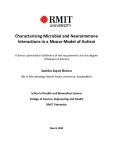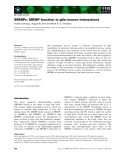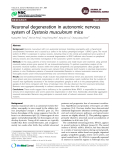
Autonomic nervous system
-
The aims of the study "Characterising microbial and neuroimmune interactions in a mouse model of autism" are threefold: i) To characterize the influence of the R451C mutation on caecal enteric neuron organization; ii) To characterize the influence of the R451C mutation on caecal patch macrophage density and morphology; iii) To assess for alterations in gut microbes in different regions of the GI tract in the NL3R451C mouse model of autism.
 83p
83p  runthenight04
runthenight04
 02-02-2023
02-02-2023
 8
8
 1
1
 Download
Download
-
The mammalian nervous system is relatively autonomous in lipid metabolism. In particular, Schwann cells in the peripheral nervous system, and oligodendrocytes and astrocytes in the central nervous system, are highly active in lipid synthesis.
 9p
9p  vinaphone15
vinaphone15
 27-02-2013
27-02-2013
 45
45
 3
3
 Download
Download
-
Tuyển tập các báo cáo nghiên cứu về y học được đăng trên tạp chí y học quốc tế cung cấp cho các bạn kiến thức về ngành y đề tài: Neuronal degeneration in autonomic nervous system of Dystonia musculorum mice
 10p
10p  toshiba23
toshiba23
 18-11-2011
18-11-2011
 34
34
 3
3
 Download
Download
-
Neurogenic shock is shock caused by the sudden loss of the autonomic nervous system signals to the smooth muscle in vessel walls. This can result from severe central nervous system (brain and spinal cord) damage. With the sudden loss of background sympathetic stimulation, the vessels suddenly relax resulting in a sudden decrease in peripheral vascular resistance (vasodilatation) and decreased blood pressure.
 4p
4p  truongthiuyen1
truongthiuyen1
 09-06-2011
09-06-2011
 62
62
 3
3
 Download
Download
-
Hệ thần kinh thực vật (Autonomic Nervous System) là để chỉ những cơ quan hệ thống trong cơ thể chịu sự chi phối của những bộ phận thần kinh hoạt động có tính chất tự động, không theo ý muốn của con người, như là hoạt động thần kinh của loài thực vật như hoạt động của tim, của cơ quan hô hấp, hệ tiêu hóa...
 6p
6p  bunbo1
bunbo1
 25-07-2010
25-07-2010
 105
105
 19
19
 Download
Download
CHỦ ĐỀ BẠN MUỐN TÌM

















